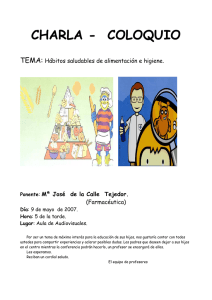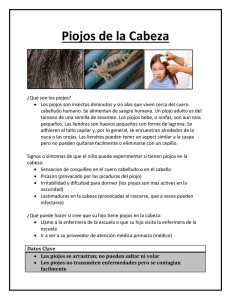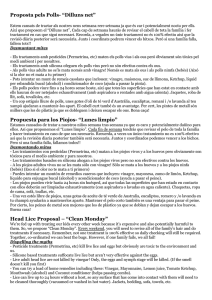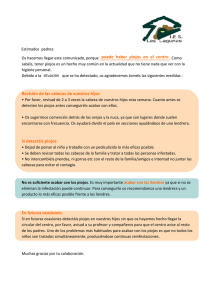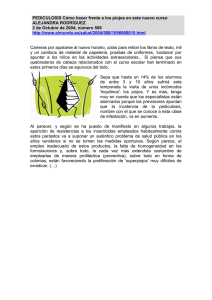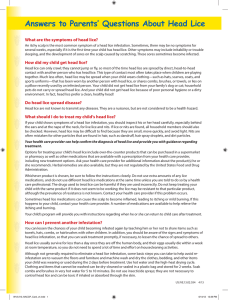General Guidelines: Treatment for head lice
Anuncio
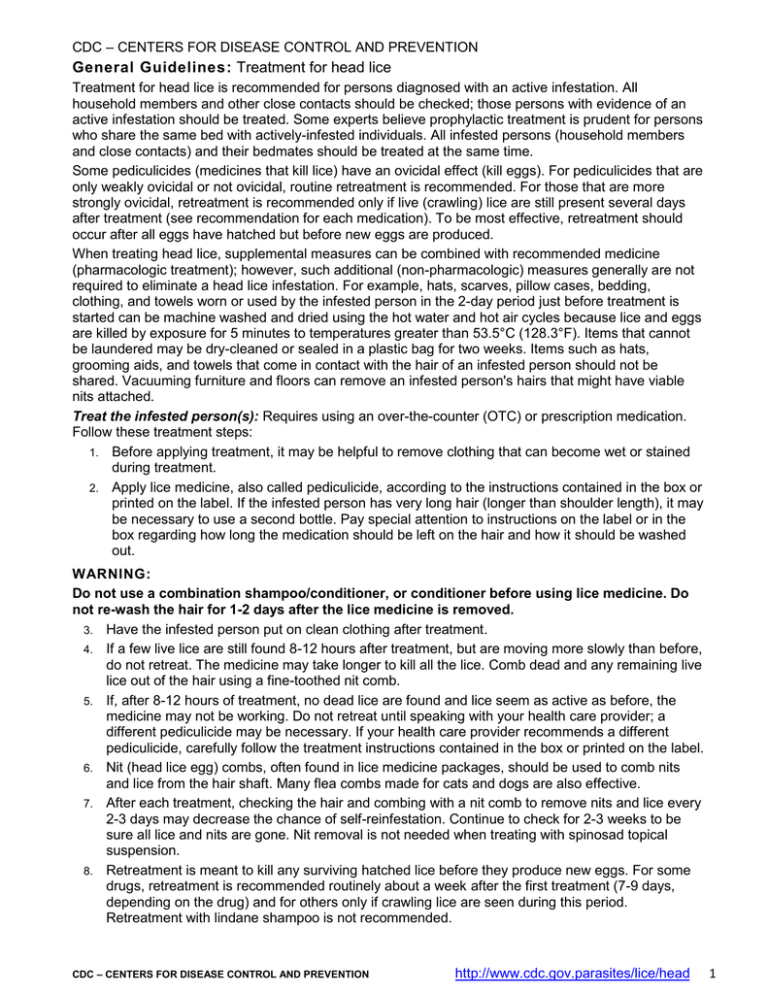
CDC – CENTERS FOR DISEASE CONTROL AND PREVENTION General Guidelines: Treatment for head lice Treatment for head lice is recommended for persons diagnosed with an active infestation. All household members and other close contacts should be checked; those persons with evidence of an active infestation should be treated. Some experts believe prophylactic treatment is prudent for persons who share the same bed with actively-infested individuals. All infested persons (household members and close contacts) and their bedmates should be treated at the same time. Some pediculicides (medicines that kill lice) have an ovicidal effect (kill eggs). For pediculicides that are only weakly ovicidal or not ovicidal, routine retreatment is recommended. For those that are more strongly ovicidal, retreatment is recommended only if live (crawling) lice are still present several days after treatment (see recommendation for each medication). To be most effective, retreatment should occur after all eggs have hatched but before new eggs are produced. When treating head lice, supplemental measures can be combined with recommended medicine (pharmacologic treatment); however, such additional (non-pharmacologic) measures generally are not required to eliminate a head lice infestation. For example, hats, scarves, pillow cases, bedding, clothing, and towels worn or used by the infested person in the 2-day period just before treatment is started can be machine washed and dried using the hot water and hot air cycles because lice and eggs are killed by exposure for 5 minutes to temperatures greater than 53.5°C (128.3°F). Items that cannot be laundered may be dry-cleaned or sealed in a plastic bag for two weeks. Items such as hats, grooming aids, and towels that come in contact with the hair of an infested person should not be shared. Vacuuming furniture and floors can remove an infested person's hairs that might have viable nits attached. Treat the infested person(s): Requires using an over-the-counter (OTC) or prescription medication. Follow these treatment steps: 1. Before applying treatment, it may be helpful to remove clothing that can become wet or stained during treatment. 2. Apply lice medicine, also called pediculicide, according to the instructions contained in the box or printed on the label. If the infested person has very long hair (longer than shoulder length), it may be necessary to use a second bottle. Pay special attention to instructions on the label or in the box regarding how long the medication should be left on the hair and how it should be washed out. WARNING: Do not use a combination shampoo/conditioner, or conditioner before using lice medicine. Do not re-wash the hair for 1-2 days after the lice medicine is removed. 3. Have the infested person put on clean clothing after treatment. 4. If a few live lice are still found 8-12 hours after treatment, but are moving more slowly than before, do not retreat. The medicine may take longer to kill all the lice. Comb dead and any remaining live lice out of the hair using a fine-toothed nit comb. 5. If, after 8-12 hours of treatment, no dead lice are found and lice seem as active as before, the medicine may not be working. Do not retreat until speaking with your health care provider; a different pediculicide may be necessary. If your health care provider recommends a different pediculicide, carefully follow the treatment instructions contained in the box or printed on the label. 6. Nit (head lice egg) combs, often found in lice medicine packages, should be used to comb nits and lice from the hair shaft. Many flea combs made for cats and dogs are also effective. 7. After each treatment, checking the hair and combing with a nit comb to remove nits and lice every 2-3 days may decrease the chance of self-reinfestation. Continue to check for 2-3 weeks to be sure all lice and nits are gone. Nit removal is not needed when treating with spinosad topical suspension. 8. Retreatment is meant to kill any surviving hatched lice before they produce new eggs. For some drugs, retreatment is recommended routinely about a week after the first treatment (7-9 days, depending on the drug) and for others only if crawling lice are seen during this period. Retreatment with lindane shampoo is not recommended. CDC – CENTERS FOR DISEASE CONTROL AND PREVENTION http://www.cdc.gov.parasites/lice/head 1 Supplemental Measures: Head lice do not survive long if they fall off a person and cannot feed. You don't need to spend a lot of time or money on housecleaning activities. Follow these steps to help avoid re-infestation by lice that have recently fallen off the hair or crawled onto clothing or furniture. 1. Machine wash and dry clothing, bed linens, and other items that the infested person wore or used during the 2 days before treatment using the hot water (130°F) laundry cycle and the high heat drying cycle. Clothing and items that are not washable can be dry-cleaned OR sealed in a plastic bag and stored for 2 weeks. 2. Soak combs and brushes in hot water (at least 130°F) for 5-10 minutes. 3. Vacuum the floor and furniture, particularly where the infested person sat or lay. However, the risk of getting infested by a louse that has fallen onto a rug or carpet or furniture is very small. Head lice survive less than 1-2 days if they fall off a person and cannot feed; nits cannot hatch and usually die within a week if they are not kept at the same temperature as that found close to the human scalp. Spending much time and money on housecleaning activities is not necessary to avoid reinfestation by lice or nits that may have fallen off the head or crawled onto furniture or clothing. 4. Do not use fumigant sprays; they can be toxic if inhaled or absorbed through the skin. Prevention & Control: Head lice are spread most commonly by direct head-to-head (hair-to-hair) contact. However, much less frequently they are spread by sharing clothing or belongings onto which lice have crawled or nits attached to shed hairs may have fallen. The risk of getting infested by a louse that has fallen onto a carpet or furniture is very small. Head lice survive less than 1-2 days if they fall off a person and cannot feed; nits cannot hatch and usually die within a week if they are not kept at the same temperature as that found close to the scalp. The following are steps that can be taken to help prevent and control the spread of head lice: 1. Avoid head-to-head (hair-to-hair) contact during play and other activities at home, school, and elsewhere (sports activities, playground, slumber parties, camp). 2. Do not share clothing such as hats, scarves, coats, sports uniforms, hair ribbons, or barrettes. 3. Do not share combs, brushes, or towels. Disinfest combs and brushes used by an infested person by soaking them in hot water (at least 130°F) for 5-10 minutes. 4. Do not lie on beds, couches, pillows, carpets, or stuffed animals that have recently been in contact with an infested person. Over-the-counter Medications Many head lice medications are available "over-the-counter" without a prescription at a local drug store or pharmacy. Each over-the-counter product approved by the FDA for the treatment of head lice contains one of the following active ingredients. If crawling lice are still seen after a full course of treatment contact your health care provider. 1. Pyrethrins combined with piperonyl butoxide; Brand name products: A-200*, Pronto*, R&C*, Rid*, Triple X*. Pyrethrins are naturally occurring pyrethroid extracts from the chrysanthemum flower. Pyrethrins are safe and effective when used as directed. Pyrethrins can only kill live lice, not unhatched eggs (nits). A second treatment is recommended on day 9 to kill any newly hatched lice before they can produce new eggs. Pyrethrins generally should not be used by persons who are allergic to chrysanthemums or ragweed. Pyrethrin is approved for use on children 2 years of age and older. 2. Permethrin lotion, 1%; Brand name product: Nix*. Permethrin is a synthetic pyrethroid similar to naturally occurring pyrethrins. Permethrin lotion 1% is approved by the FDA for the treatment of head lice. Permethrin is safe and effective when used as directed. Permethrin kills live lice but not unhatched eggs. Permethrin may continue to kill newly hatched lice for several days after treatment. A second treatment often is necessary on day 9 to kill any newly hatched lice before they can produce new eggs. Permethrin is approved for use on children 2 months of age and older. CDC – CENTERS FOR DISEASE CONTROL AND PREVENTION http://www.cdc.gov.parasites/lice/head 2 Prescription Medications The following medications, in alphabetical order, approved by the U.S. Food and Drug Administration (FDA) for the treatment of head lice are available only by prescription. If crawling lice are still seen after a full course of treatment, contact your health care provider. 1. Benzyl alcohol lotion, 5%; Brand name product: Ulesfia lotion* Benzyl alcohol is an aromatic alcohol. Benzyl alcohol lotion, 5% has been approved by the FDA for the treatment of head lice and is considered safe and effective when used as directed. It kills lice but it is not ovicidal. A second treatment is needed 7 days after the first treatment to kill any newly hatched lice before they can produce new eggs. Benzyl alcohol lotion is intended for use on persons who are 6 months of age and older and its safety in persons aged more 60 years has not been established. It can be irritating to the skin. 2. Ivermectin lotion, 0.5%; Brand name product: Sklice* Given as a tablet in mass drug administrations, ivermectin has been used extensively and safely for over two decades in many countries to treat filarial worm infections. Ivermectin lotion, 0.5% was approved by the FDA in 2012 for treatment of head lice in persons 6 months of age and older. It is not ovicidal, but appears to prevent nymphs (newly hatched lice) from surviving. It is effective in most patients when given as a single application on dry hair without nit combing. It should not be used for retreatment without talking to a healthcare provider. 3. Malathion lotion, 0.5%; Brand name product: Ovide* Malathion is an organophosphate. The formulation of malathion approved in the United States for the treatment of head lice is a lotion that is safe and effective when used as directed. Malathion is pediculicidal (kills live lice) and partially ovicidal (kills some lice eggs). A second treatment is recommended if live lice still are present 7-9 days after treatment. Malathion is intended for use on persons 6 years of age and older. Malathion can be irritating to the skin. Malathion lotion is flammable; do not smoke or use electrical heat sources, including hair dryers, curlers, and curling or flat irons, when applying malathion lotion and while the hair is wet. 4. Spinosad 0.9% topical suspension; Brand name product: Natroba* Spinosad is derived from soil bacteria. Spinosad topical suspension, 0.9%, was approved by the FDA in 2011. Since it kills live lice as well as unhatched eggs, retreatment is usually not needed. Nit combing is not required. Spinosad topical suspension is approved for the treatment of children 4 years of age and older. It is safe and effective when used as directed. Repeat treatment should be given only if live (crawling) lice are seen 7 days after the first treatment. For second-line treatment only: 5. Lindane shampoo 1%; Brand name products: None available Lindane is an organochloride. The American Academy of Pediatrics (AAP) no longer recommends it as a pediculocide. Although lindane shampoo 1% is approved by the FDA for the treatment of head lice, it is not recommended as a first-line treatment. Overuse, misuse, or accidentally swallowing lindane can be toxic to the brain and other parts of the nervous system; its use should be restricted to patients for whom prior treatments have failed or who cannot tolerate other medications that pose less risk. Lindane should not be used to treat premature infants, persons with HIV, a seizure disorder, women who are pregnant or breast-feeding, persons who have very irritated skin or sores where the lindane will be applied, infants, children, the elderly, and persons who weigh less than 110 pounds. Retreatment should be avoided. CDC – CENTERS FOR DISEASE CONTROL AND PREVENTION http://www.cdc.gov.parasites/lice/head 3 When treating head lice 1. Do not use extra amounts of any lice medication unless instructed to do so by your physician and pharmacist. The drugs used to treat lice are insecticides and can be dangerous if they are misused or overused. 2. All the medications listed above should be kept out of the eyes. If they get onto the eyes, they should be immediately flushed away. 3. Do not treat an infested person more than 2-3 times with the same medication if it does not seem to be working. This may be caused by using the medicine incorrectly or by resistance to the medicine. Always seek the advice of your health care provider if this should happen. He/she may recommend an alternative medication. 4. Do not use different head lice drugs at the same time unless instructed to do so by your physician and pharmacist. *Use of trade names is for identification purposes only and does not imply endorsement by the Public Health Service or by the U.S. Department of Health and Human Services. Page last reviewed: November 2, 2010 Page last updated: November 2, 2010 Content source: Global Health - Division of Parasitic Diseases and Malaria Notice: Linking to a non-federal site does not constitute an endorsement by HHS, CDC or any of its employees of the sponsors or the information and products presented on the site. Centers for Disease Control and Prevention 1600 Clifton Rd. Atlanta, GA 30333, USA 800-CDC-INFO (800-232-4636) TTY: (888) 232-6348 - Contact CDC–INFO CDC – CENTERS FOR DISEASE CONTROL AND PREVENTION http://www.cdc.gov.parasites/lice/head 4 Centros para el Control y la Prevención de Enfermedades Recomendaciones generales: Tratamiento para piojos Las personas a las que se les ha diagnosticado una infestación activa de piojos de la cabeza requieren de un tratamiento. Asímismo, se deben examinar todos los miembros de la familia y otras personas cercanas, y, si presentan signos de infestación activa, también deben tratarse. Algunos especialistas creen que es prudente un tratamiento profiláctico en las personas que comparten la misma cama con las que presentan una infestación activa de piojos de la cabeza. Todas las personas infestadas (miembros de la familia y personas cercanas) así como sus compañeros de cama deben ser tratados al mismo tiempo. Por lo general, se recomienda repetir el tratamiento, porque no existe ningún pediculicida (medicamento para eliminar piojos) aprobado en el mercado que sea completamente ovicida (que mata los huevos). Para que sea más eficaz, el tratamiento debe hacerse después de que todos los huevos de los piojos hayan eclosionado pero antes de que haya nuevas incubaciones. El plazo para la repetición del tratamiento puede variar en función del pediculicida que se utilice. Cuando se traten los piojos de la cabeza, se pueden tomar medidas complementarias aparte del medicamento (tratamiento farmacológico); sin embargo, estas medidas (no farmacológicas) por lo general no son esenciales para eliminar una infestación de piojos. Por ejemplo, se pueden lavar con agua caliente en una lavadora y secar en secadora, con ciclo de aire caliente, sombreros, bufandas, fundas de almohadas, ropa de cama, prendas de vestir y toallas que haya utilizado la persona infestada en los dos días antes de que comenzara el tratamiento, ya que los piojos y los huevos mueren al quedar expuestos durante 5 minutos a temperaturas mayores de 53.5°C (128.3°F). Los productos que no se pueden lavar con agua se pueden llevar a la tintorería para lavado en seco o guardarse en bolsas de plástico selladas durante dos semanas. No se deben compartir artículos como sombreros, toallas y productos para el cuidado del cabello que hayan estado en contacto con el cabello de la persona infestada. Si se pasa la aspiradora por los muebles y pisos se pueden limpiar los cabellos que hayan caído de una persona infestada y que puedan tener liendres viables. Tratamiento de la persona o personas infestadas: Requiere el uso de medicamentos recetados o de venta sin receta. Siga estas recomendaciones: 1. Antes de administrar el tratamiento es recomendable quitarse la ropa que pueda mojarse o mancharse con el medicamento. 2. Aplique el medicamento contra los piojos o pediculicida siguiendo las instrucciones que vienen en la caja o que están impresas en la etiqueta. Si la persona infestada tiene el cabello muy largo (que sobrepase los hombros), puede ser necesario un segundo frasco. Ponga especial atención a las instrucciones en la etiqueta o la caja sobre cuánto tiempo debe dejarse el medicamento en el cabello y cómo se debe enjuagar. ADVERTENCIA: No use enjuagues en crema ni champú y acondicionador antes de aplicar el medicamento contra los piojos. No lave de nuevo el cabello durante 1 o 2 días después de haber enjuagado el medicamento. 3. Después del tratamiento la persona infestada debe ponerse un cambio de ropa limpia. 4. Si de 8 a 12 horas después del tratamiento se encuentran unos pocos piojos vivos, pero se mueven más lentamente que antes, no repita el tratamiento. Puede ser que el medicamento tarde un poco más en matar todos los piojos. Peine el cabello con el peine fino especial para eliminar liendres a fin de extraer todos los piojos muertos y los que sigan vivos. 5. Si de 8 a 12 horas después del tratamiento no se encuentran piojos muertos y los piojos parecen estar tan activos como antes, tal vez el medicamento no esté surtiendo efecto. No repita el tratamiento hasta no hablar con su proveedor de cuidados médicos; puede ser necesario un medicamento distinto contra piojos (pediculicida). Si su proveedor de cuidados médicos recomienda un pediculicida diferente, siga con atención las instrucciones del tratamiento que vienen en la caja o en la etiqueta impresa. 6. Se deben utilizar los peines especiales para eliminar liendres (huevos de los piojos) que usualmente vienen en los empaques de los medicamentos contra piojos, pasándolos desde el área donde nace el cabello. También son eficaces muchos peines hechos para extraer pulgas de gatos y perros. CDC – CENTERS FOR DISEASE CONTROL AND PREVENTION http://www.cdc.gov.parasites/lice/head 5 Para disminuir la probabilidad de autoreinfestación después del tratamiento, examine visualmente el cabello y pásele el peine especial para eliminar piojos y liendres cada 2 o 3 días. Continúe haciendo los exámenes visuales durante 2 o 3 semanas hasta asegurarse de que todos los piojos y liendres han desaparecido. 8. Por lo general, la mayoría de los medicamentos que se venden con o sin receta requieren que se repita el tratamiento 9 o 10 días después de su administración para matar los piojos sobrevivientes que nacieron de las liendres antes de que produzcan huevos. Sin embargo, si utiliza el medicamento recetado malatión, el tratamiento se debe repetir entre 7 y 9 días después ÚNICAMENTE si ve piojos moviéndose. Medidas complementarias: Los piojos de la cabeza no sobreviven mucho tiempo si se desprenden de una persona y no pueden alimentarse. Usted no necesita gastar mucho tiempo o dinero en limpiar la vivienda. Siga estos pasos para evitar la reinfestación de los piojos que se han desprendido recientemente del cabello o que han pasado a la ropa o los muebles. 1. Lave en la lavadora la ropa de cama y las demás prendas que haya utilizado la persona infestada en los 2 días anteriores al tratamiento; use agua caliente (130°F) y para secar seleccione una temperatura elevada en la secadora. La ropa y los artículos que no se pueden lavar con agua se pueden llevar a la tintorería para lavar en seco. O guarde la ropa durante 2 semanas en una bolsa de plástico sellada. 2. Remoje los peines y cepillos en agua caliente (al menos 130°F) durante 5 a 10 minutos. 3. Pase la aspiradora en el suelo y los muebles, especialmente donde la persona infestada se sentó o se acostó. No obstante, hay un mínimo riesgo de infestación si un piojo ha caído en la alfombra o el sofá. Los piojos de la cabeza sobreviven menos de 1 a 2 días si se desprenden de una persona y no pueden alimentarse; las liendres no pueden eclosionar y por lo general mueren después de una semana si no se encuentran bajo una temperatura similar a la del cuero cabelludo humano. Sin embargo, no es necesario invertir mucho tiempo ni dinero en la limpieza del hogar para evitar una reinfestación de piojos o liendres que pueden haberse desprendido de la cabeza y pasado a los muebles o la ropa. 4. No fumigue con aerosoles; pueden ser tóxicos si se inhalan o se absorben por la piel. Cómo prevenir reinfestación: Los piojos de la cabeza se transmiten más frecuentemente por el contacto directo de cabeza con cabeza (cabello a cabello) y con menos frecuencia por compartir ropa o pertenencias personales donde se han pasado los piojos o las liendres. El riesgo de infestación por un piojo que ha caído en la alfombra o el sofá es mínimo. Los piojos de la cabeza sobreviven menos de 1 a 2 días si se desprenden de una persona y no pueden alimentarse; las liendres no pueden eclosionar y por lo general mueren después de una semana si no se encuentran bajo una temperatura similar a la del cuero cabelludo humano. 7. Los siguientes pasos pueden ayudar a prevenir y controlar la transmisión de piojos: 1. Evitar el contacto de cabeza con cabeza (cabello a cabello) al jugar y realizar otras actividades en el hogar, la escuela y otras instancias (actividades deportivas, parques, fiestas de pijamas, campamentos). Los piojos de la cabeza se transmiten más frecuentemente por el contacto directo de cabeza con cabeza (cabello a cabello) y con menos frecuencia por compartir ropa o pertenencias personales donde pueden haberse pasado piojos o liendres. 2. No comparta prendas de vestir como sombreros, bufandas, abrigos, uniformes deportivos, cintas del cabello o broches. 3. No comparta peines, cepillos para el cabello o toallas infestados. 4. No se recueste en camas, sofás, almohadas, alfombras o animales de peluche que hayan estado recientemente en contacto con una persona infestada. CDC – CENTERS FOR DISEASE CONTROL AND PREVENTION http://www.cdc.gov.parasites/lice/head 6 Medicamentos que no requieren receta Muchos medicamentos para tratar piojos se pueden adquirir sin receta médica en la farmacia local. Estos productos que se venden sin receta médica, cuyo uso está aprobado para el tratamiento de los piojos de la cabeza, y contienen alguno de los siguientes ingredientes activos. 1. Piretrinas con frecuencia combinadas con butóxido de piperonilo; Nombres comerciales de los productos: Algunos nombres comerciales de los productos son A200*, Pronto*, R&C*, Rid*, Triple X*. Las piretrinas son piretroides naturales que se extraen de la flor del crisantemo. Las piretrinas son seguras y eficaces si se utilizan en la forma indicada. Estas sustancias solo matan piojos vivos, no los huevos que no han eclosionado (liendres). Se recomienda un segundo tratamiento de 9 a 10 días después de administrado el primero, para eliminar los piojos maduros antes de que puedan incubar. Los tratamientos pueden resultar ineficaces si los piojos se vuelven resistentes a las piretrinas en el área geográfica del paciente. Las piretrinas no se deben administrar en personas alérgicas al crisantemo o a la ambrosía. 2. Permetrina: Nombre comercial del producto: Nix*. La permetrina es un piretroide sintético similar a las piretrinas naturales. La permetrina es segura y eficaz si se utiliza en la forma indicada. Esta sustancia mata los piojos vivos pero no sus huevos inmaduros. Su efecto puede continuar y así seguir matando huevos eclosionados varios días después del tratamiento. Se necesita un segundo tratamiento 9 a10 días después de administrado el primero, para eliminar los piojos recién eclosionados antes de que puedan incubar. Con frecuencia este tratamiento no es eficaz si los piojos se vuelven resistentes a la permetrina en el área geográfica del paciente. La permetrina no está aprobada para usarse en niños menores de 2 años de edad. Medicamentos recetados La Administración de Drogas y Alimentos (FDA) ha aprobado los medicamentos siguientes para el tratamiento de los piojos de la cabeza y estos solo están disponibles con receta médica. 1. Malatión; Nombre comercial del producto: Ovide* El malatión es un organofosfato. La preparación del malatión para el tratamiento de los piojos de la cabeza, aprobada en Estados Unidos, es una loción segura y eficaz cuando se usa en la forma indicada. El malatión es una sustancia pediculicida (mata piojos vivos) y parcialmente ovicida (mata algunos huevos de los piojos). Se recomienda un segundo tratamiento si todavía hay piojos vivos 7 a 9 días después del tratamiento inicial. El malatión es solamente apto para usarse en personas mayores de 6 años de edad. Este medicamento puede irritar la piel y el cuero cabelludo, y se debe evitar el contacto con los ojos. La loción de malatión es inflamable; cuando se administre, no se debe fumar ni utilizar artículos eléctricos con superficies que emitan calor, como las secadoras, las pinzas o las planchas para el cabello. Visite esta página para consultar más información sobre el tratamiento con malatión (en inglés). 2. Lindano; Nombres comerciales de los productos: No disponibles El lindano es un organoclorado. No se recomienda lindano como tratamiento de primera línea. El uso excesivo o inadecuado o la ingestión accidental de lindano puede ser tóxico para el cerebro y otras partes del sistema nervioso; su uso debe limitarse a casos en que no han funcionado los tratamientos con otros medicamentos que conllevan menos riesgos, o que los pacientes no puedan tolerarlos. El lindano no debe utilizarse para tratar bebés prematuros, personas con trastornos convulsivos, mujeres embarazadas o lactantes, personas que tienen la piel muy irritada o heridas en las zonas donde se aplicará el medicamento, bebés, niños, ancianos o persanas que pesan menos de 110 libras. CDC – CENTERS FOR DISEASE CONTROL AND PREVENTION http://www.cdc.gov.parasites/lice/head 7 ¿Qué medicamento es mejor? Si usted no está seguro sobre qué medicamento elegir o cómo utilizar un medicamento en especial, consulte siempre a su médico, farmaceuta u otro proveedor de cuidados médicos. Los CDC no emiten recomendaciones sobre productos específicos. Cuando utilice un medicamento, siga siempre con atención las instrucciones que se acompañan en el empaque o en la etiqueta impresa, a menos que el médico o el farmaceuta le den otras indicaciones. 1. Qué hacer durante el tratamiento de los piojos de la cabeza No utilice cantidades adicionales del medicamento contra los piojos a menos que así se lo indique su médico o farmaceuta. Los medicamentos para tratar los piojos son insecticidas y pueden ser peligrosos si se usan en forma excesiva o inadecuada. 2. No trate a la persona infestada más de 2 o 3 veces con el mismo medicamento si parece que este producto no está dando resultados. Esto puede deberse a una utilización incorrecta del medicamento o a que hay resistencia a él. Consulte siempre con su proveedor de cuidados médicos si sucede esto, para que le recomiende un medicamento alternativo. 3. No utilice al mismo tiempo dos medicamentos distintos para tratar piojos de la cabeza a menos que así se lo indique su médico o farmaceuta. *La referencia a marcas registradas se hace solamente a manera de identificación y no implica que dichas marcas sean respaldadas por el Servicio de Salud Pública y el Departamento de Salud y Servicios Humanos de los Estados Unidos. http://www.cdc.gov/parasites/lice/head/es/tratamiento.html Esta página fue revisada el 2 de noviembre del 2010 Esta página fue modificada el 2 de noviembre del 2010 Fuente del contenido: Mundial de la Salud - División de Enfermedades Parasitarias y la Malaria Aviso: vínculos a un sitio no federal no constituye un endoso por el HHS, los CDC ni ninguno de sus empleados de los patrocinadores o la información y productos presentados en el sitio. . Centros para el Control y la Prevención de Enfermedades 1600 Clifton Rd. Atlanta, GA 30333, USA 800-CDC-INFO (800-232-4636) Línea TTY: (888) 232-6348 Comuníquese con CDC–INFO http://www.cdc.gov/parasites/lice/head/es/tratamiento.html CDC – CENTERS FOR DISEASE CONTROL AND PREVENTION http://www.cdc.gov.parasites/lice/head 8
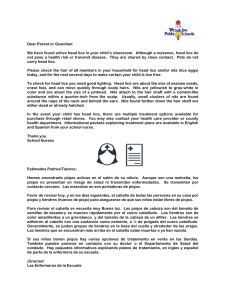
![[Nombre del enfermero] [Dirección de la escuela] [Teléfono] [Fecha](http://s2.studylib.es/store/data/006272236_1-01e6a6b03c5d2ac6332af896d75b79ea-300x300.png)
![[Teléfono] [Fecha actual] Asunto: Educación sobre los piojos](http://s2.studylib.es/store/data/006418779_1-476a23d56ab757452eb1eaaf82f05fe3-300x300.png)
